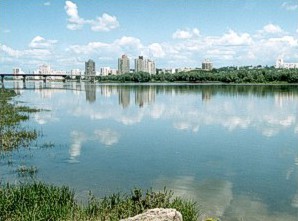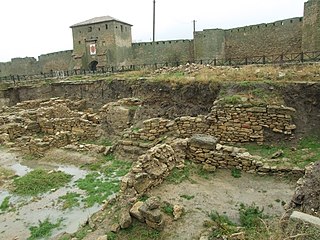
Sozopol is an ancient seaside town located 35 km south of Burgas on the southern Bulgarian Black Sea Coast. One of the major seaside resorts in the country, it is known for the Apollonia art and film festival that is named after one of the town's ancient names. Part of Burgas Province and administrative centre of the homonymous Sozopol Municipality, as of December 2009, the town has a population of 5,410 inhabitants.

The Dniester is a transboundary river in Eastern Europe. It runs first through Ukraine and then through Moldova, finally discharging into the Black Sea on Ukrainian territory again.

The Bosporan Kingdom, also known as the Kingdom of the Cimmerian Bosporus, was an ancient Greco-Scythian state located in eastern Crimea and the Taman Peninsula on the shores of the Cimmerian Bosporus, centered in the present-day Strait of Kerch. It was the first truly 'Hellenistic' state, in the sense that a mixed population adopted the Greek language and civilization, under aristocratic consolidated leadership. Under the Spartocid dynasty, the aristocracy of the kingdom adopted a double nature of presenting themselves as archons to Greek subjects and as kings to barbarians, which some historians consider unique in ancient history. The Bosporan Kingdom became the longest surviving Roman client kingdom. The 1st and 2nd centuries AD saw a period of a new golden age of the Bosporan state. It was briefly incorporated as part of the Roman province of Moesia Inferior from AD 63 to 68 under Emperor Nero, before being restored as a Roman client kingdom. At the end of the 2nd century AD, King Sauromates II inflicted a critical defeat on the Scythians and included all the territories of the Crimean Peninsula in the structure of his state.

The Indo-Greek Kingdom, also known as the Yavana Kingdom, was a Hellenistic-era Greek kingdom covering various parts of modern-day Afghanistan, Pakistan and northwestern India.

Bilhorod-Dnistrovskyi, historically known as Aq Kirmān or by other names, is a port city in Odesa Oblast, southwestern Ukraine. It is situated on the right bank of the Dniester Estuary leading to the Black Sea, in the historical region of Budjak. It also serves as the administrative center of Bilhorod-Dnistrovskyi Raion and is coterminous with Bilhorod-Dnistrovskyi urban hromada, one of the hromadas of Ukraine. It is the location of a large freight seaport. Population: 47,727.

Pontic Olbia or simply Olbia is an archaeological site of an ancient Greek city on the shore of the Southern Bug estuary in Ukraine, near the village of Parutyne. The archaeological site is protected as the National Historic and Archaeological Reserve. The reserve is a research and science institute of the National Academy of Sciences of Ukraine. In 1938–1993 it was part of the NASU Institute of Archaeology as a department.

Phanagoria was the largest ancient Greek city on the Taman peninsula, spread over two plateaus along the eastern shore of the Cimmerian Bosporus.

Greek Crimea concerns the ancient Greek settlements on the Crimean Peninsula. Greek city-states first established colonies along the Black Sea coast of Crimea in the 7th or 6th century BC. Several colonies were established in the vicinity of the Kerch Strait, then known as the Cimmerian Bosporus. The density of colonies around the Cimmerian Bosporus was unusual for Greek colonization and reflected the importance of the area. The majority of these colonies were established by Ionians from the city of Miletus in Asia Minor. By the mid-1st century BC the Bosporan Kingdom became a client state of the late Roman Republic, ushering in the era of Roman Crimea during the Roman Empire.

Tyras was an ancient Greek city on the northern coast of the Black Sea. It was founded by colonists from Miletus, probably about 600 BC. The city was situated some 10 km from the mouth of the Tyras River, which is now called the Dniester. The surrounding native tribe was called the Tyragetae. The ruins of Tyras are now located in the modern city of Bilhorod-Dnistrovskyi in the Odesa Oblast of Ukraine.

Berezan is an island in the Black Sea at the entrance of the Dnieper-Bug Estuary, Mykolaiv Raion, Mykolaiv Oblast, Ukraine. Located 8 kilometers from the city of Ochakiv and 4 kilometers from the resort village of Rybakivka. It is often being confused with the artificial island of Pervomaisky that is located within Dnieper-Bug Estuary. The Berezan island measures approximately 900 metres in length by 320 metres in width, the height of the northern part is 3-6 metres, the southern part is 21 metres. It is separated from the mainland by about a mile and a half of shallow water. Berezan is an integral part of the historical and archaeological reserve of the National Academy of Sciences of Ukraine "Olbia". The island is uninhabited. In the summer, archaeological expeditions of the IA NASU and the State Hermitage Museum work here. The archaeological site is regularly destroyed as a result of unauthorized excavations.

The Odesa Numismatics Museum is a currency museum in Ukraine. The museum preserves and exhibits ancient relics from the Northern Black Sea Region and Rus-Ukraine.

Histria or Istros was founded as a Greek colony or polis on the western coast of the Black Sea near the mouth of the Danube whose banks are today about 70 km away. In antiquity, it also bore the names Istropolis, Istriopolis, and Histriopolis or simply Istros/Histros (Ἴστρος). It is near the modern town of Istria.

Scythia or Scythica was a geographic region defined in the ancient Graeco-Roman world that encompassed the Pontic–Caspian steppe. It was inhabited by Scythians, an ancient Eastern Iranian equestrian nomadic people.

Nýmphaion, also known as Nymphaion on the Pontus, was a significant centre of the Bosporan Kingdom, situated on the Crimean shore of the Cimmerian Bosporus. Today it is located near the resort town Heroivske. It lies at a distance of about 14 kilometers south of Kerch, which was the site of ancient Panticapaeum.

Argamum was originally an ancient Greek city located on the coast of the Black Sea on the present Cape Dolosman in Romania near Jurilovca, on the coastal lagoon that in ancient times was the open sea. It was founded by Greek colonists from Asia Minor together with other nearby cities.

Greek colonisation refers to the expansion of Archaic Greeks, particularly during the 8th–6th centuries BC, across the Mediterranean Sea and the Black Sea.

Scyles, Skyles, or Scylas, was a Scythian king who lived in the 5th century BC. He is mentioned in the histories of Herodotus as having been an admirer of Greek culture and traditions, which led to his falling out of favor with his people and being executed by his brother.

Petro Karyshkovsky-Ikar was a Ukrainian Soviet historian, numismatist, a scholar and lexicographer.

The Odesa Archaeological Museum is one of the oldest archaeological museums in Ukraine. It was founded in 1825; the current museum building was completed in 1883 according to a design by Polish architect Feliks Gąsiorowski.

Odesa Oblast, also referred to as Odeshchyna (Одещина), is an oblast (province) of southwestern Ukraine, located along the northern coast of the Black Sea. Its administrative centre is the city of Odesa. Population: 2,351,382.






















